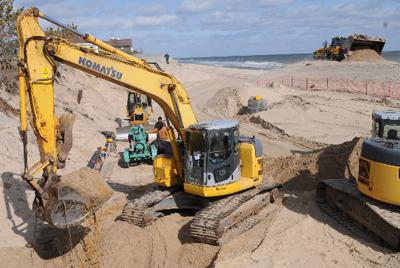Work Resumes on Disputed Georgica Beach Sea Wall

Mollie Zweig's lengthy effort to build a rock revetment in front of her oceanfront property at 11 West End Road in East Hampton Village resumed yesterday after State Supreme Court Justice Andrew Tarantino lifted a temporary restraining order that had blocked the work since November.
The New York State Department of Environmental Conservation had initially given her a tidal wetlands permit, and the East Hampton Village Zoning Board of Appeals had granted variances to allow construction of the revetment, or sea wall, as well as the removal of an existing rock groin.
The zoning board's determination had come over the strong objection of the East Hampton Town Trustees, which claimed jurisdiction over the beach on which the revetment would be constructed.
Two days after work suddenly began on Veterans Day 2013 -- when courts were closed -- the trustees obtained a temporary restraining order. The order was extended in December. Last month, Ms. Zweig applied for a permit from the trustees, as that board has insisted she is required to do.
Stephen Angel, an attorney representing Ms. Zweig, and Aram Terchunian of First Coastal, which is doing the work, delivered a lengthy presentation to the trustees detailing the project. Mr. Angel said that a timely resolution was essential, given the piping plover nesting season that, beginning next month, will prohibit construction activity on beaches until the fall. That application is still pending.
At a meeting on Tuesday, Diane McNally, the trustees' clerk, said that the application was incomplete and that the board had sent a letter to Ms. Zweig seeking an updated survey. She also said that the notarization page on the application had not been signed. Brian Matthews, an attorney from the law firm that is representing the trustees in their lawsuit against Ms. Zweig, also met with the trustees on the matter during a closed-door session at that meeting.
Ms. McNally said on Friday that she was frustrated but not entirely surprised by the resumption of the revetment's construction. "They already know they're proceeding without a trustee permit," Ms. McNally said on Friday. "They know we're not happy with what they're doing. I don't know what to do. Even though I knew it could have started, I'm just flabbergasted."
Mr. Matthews would not say how the trustees planned to proceed, but said on Friday that the lifting of the temporary restraining order should not be seen as a resolution in Ms. Zweig's favor. "When Justice Tarantino lifted the T.R.O., he did so entirely on the grounds of finding no irreparable harm. Since Zweig had submitted an application to the trustees, there was no longer any irreparable harm and allowed her to proceed with construction," he said.
Mr. Matthews said he disagreed with that position, "but the important part is, he went out of his way to say that he wasn't rendering a decision on the merits of the trustees' claim . . . . In stating that he wasn't looking at the merits, he acknowledged that they're going to be building this at their own risk . . . . They run the risk of having to pull it out," he said.
Mr. Matthews said that an important objective of the lawsuit was to get Ms. Zweig to apply for a permit from the trustees. But, he said, "The application is not only incomplete, it's inconsistent with what the village approved."
The Village Zoning Board of Appeals, he said, had approved construction of a revetment that would be 166 feet long, but the application to the trustees described a revetment 171 feet long. "These revetments are highly technical, so any differences are significant in our view," he said.
"I have no idea what he is talking about," Mr. Angel said. The revetment, he said, is "being built in accordance with the permit issued by the D.E.C. and the village. The only reason we went to the trustees was, without prejudice to our position that we didn't have to go, [to] attempt to settle the case." The trustees, he said, "are trying to make an issue out of nothing."
